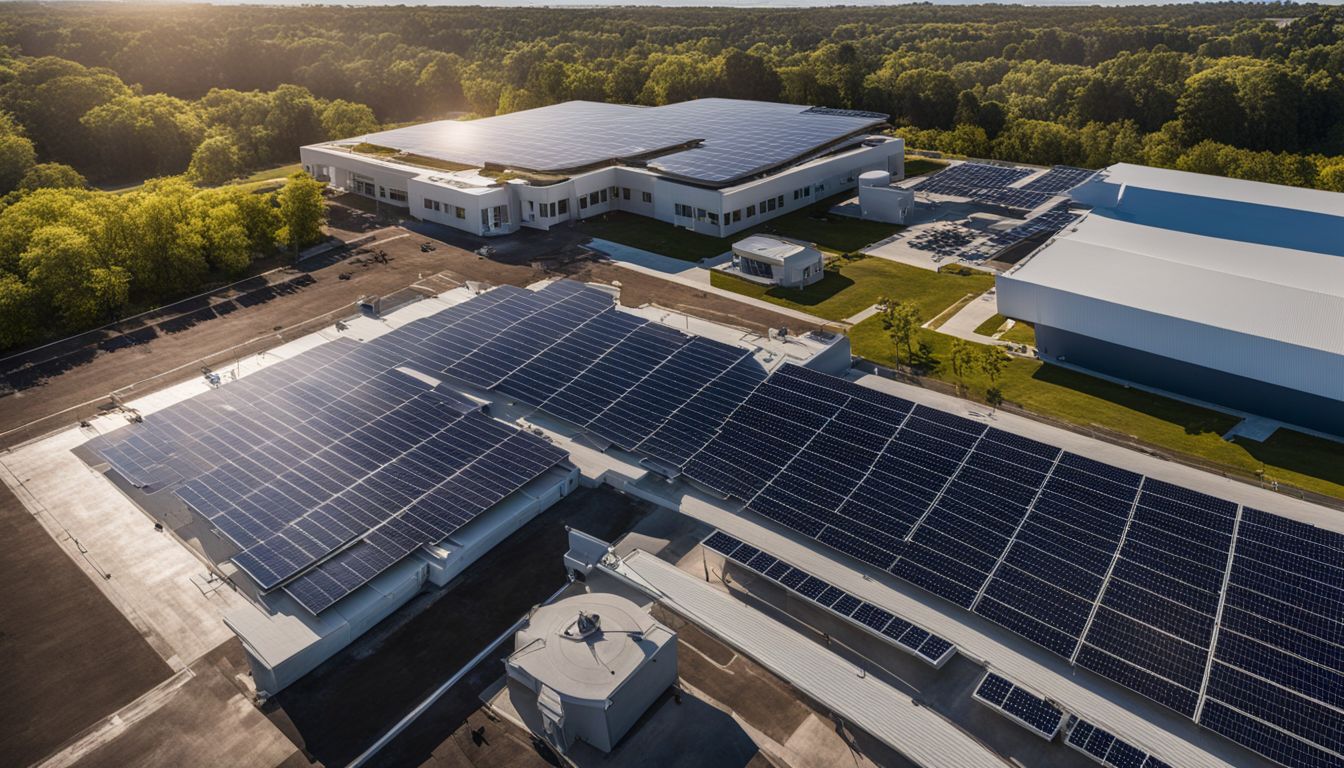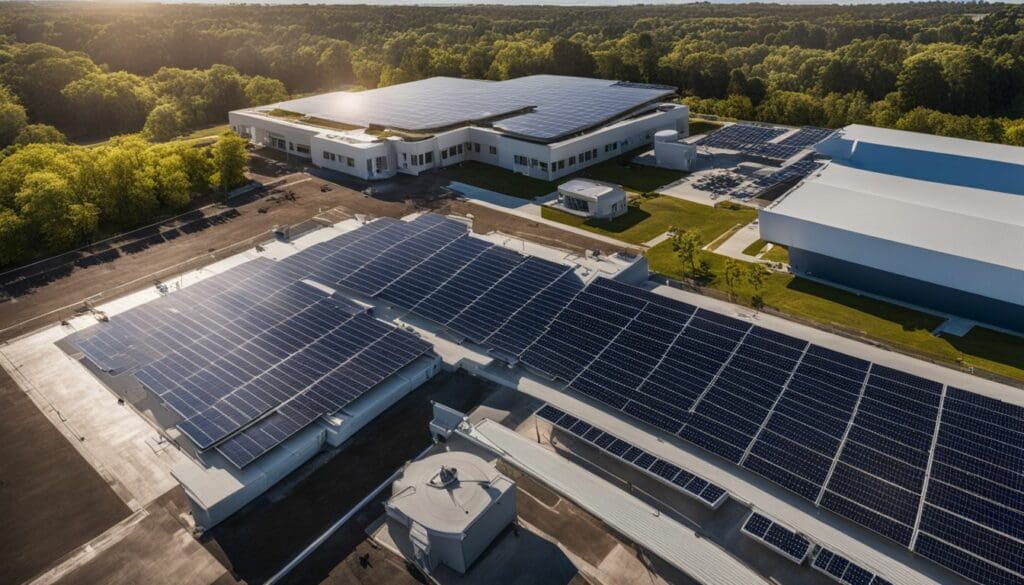 Energy bills are soaring, and schools are feeling the pinch just like everyone else. Renewable energy can cut costs while also protecting our planet. This guide will show you how schools can make a powerful switch to sustainable energy, reaping benefits for both the budget and the environment.
Energy bills are soaring, and schools are feeling the pinch just like everyone else. Renewable energy can cut costs while also protecting our planet. This guide will show you how schools can make a powerful switch to sustainable energy, reaping benefits for both the budget and the environment.
Let’s empower the next generation with green choices!
Key Takeaways
- Sustainable energy practices like using solar, wind power and implementing energy conservation can lower school’s costs and carbon footprint.
- Important for schools to engage in just energy transitions and include all community members as we move towards greener sources.
- Young people at the heart of sustainable initiatives, leading change with fresh ideas for a cleaner future.
- Fossil fuels harm our planet by increasing carbon emissions; switching to renewable resources is essential for environmental health.
- Integrating sustainability into school curricula empowers students with lessons on conservation and responsible energy use.
Understanding Sustainable Energy
Sustainable energy is about using resources that can be replenished, such as solar or wind power, and reducing our reliance on non-renewable sources like fossil fuels. Young people play a crucial role in advocating for a just energy transition to combat climate change.
Key concepts
Energy conservation lies at the heart of sustainable energy. It means using less power and maximising our resources efficiently. For schools, this translates into adopting practices like turning off lights when not in use and leveraging natural daylight.
Solar energy plays a significant role by providing clean power from the sun, an endlessly renewable source that does not release harmful carbon emissions.
Green education helps students understand how energy choices impact environmental sustainability. They learn why transitioning away from fossil fuels towards ecofriendly energy sources like wind power is crucial for our planet’s health.
Zero energy buildings are designed to generate as much electricity as they consume, demonstrating cutting-edge advancements in school infrastructure helping reduce carbon footprints dramatically.
Relationship with climate change
Understanding sustainable energy is crucial in the context of climate change. Fossil fuel emissions, a major contributor to climate change, can be significantly reduced by transitioning to renewable energy sources.
This shift plays a vital role in curbing carbon emissions and mitigating the impact of global warming. Every effort towards sustainable energy contributes to creating a healthier environment for future generations.
Furthermore, embracing sustainable energy aligns with the larger goal of achieving sustainable development while promoting green education. It empowers young people to take an active role in combating climate change by advocating for clean energy solutions and fostering a culture of environmental responsibility within their schools and communities.
Importance of a just energy transition
A just energy transition is crucial for ensuring fairness and equity as we shift towards sustainable energy. It involves prioritising the needs of vulnerable communities, workers, and regions most affected by the transition.
This approach aims to create opportunities for all individuals to benefit from renewable energy initiatives, address social injustices, and ensure that no one is left behind in the pursuit of a greener future.
Supporting a just energy transition means advocating for inclusive policies that consider the diverse impacts of transitioning away from fossil fuels. It recognises the importance of empowering local communities and fostering an environment where everyone can participate in and benefit from sustainable energy projects.
Role of young people
Young people play a crucial role in driving sustainable energy initiatives within schools. Their fresh perspectives and passion for environmental conservation inspire innovative ideas and solutions.
By getting involved in energy-saving programs, young individuals can create a significant impact on reducing carbon emissions and promoting green school environments.
Empowering young people to take an active part in the sustainable energy movement ensures a brighter, cleaner future for generations to come. Engaging them in sustainability projects not only benefits the environment but also instils valuable lessons that they can carry forward into their adult lives, spreading awareness of sustainable practices within their communities.
Existing Energy Options
Fossil fuels have been the traditional source of energy for schools, but it’s important to consider renewable energy sources such as solar power for a more sustainable future. Read on to learn more about why schools need to focus on sustainable energy.
Fossil fuels
Fossil fuels, such as coal, oil, and natural gas, are non-renewable energy sources that have been the primary fuel for power generation, transportation, and heating. These fuels release large amounts of carbon dioxide into the atmosphere when burned.
This is a significant contributor to climate change and air pollution. As environmentally conscious individuals concerned about conservation and reducing carbon emissions, it’s essential to understand the impact of fossil fuel consumption on our planet.
Burning fossil fuels also releases other harmful pollutants like sulfur dioxide and nitrogen oxides which contribute to smog formation and acid rain. Additionally, the extraction of these fuels can lead to habitat destruction and water contamination.
Renewable energy sources
After discussing the impact of fossil fuels, it’s crucial to explore renewable energy sources. These sustainable options include solar, wind, hydroelectric, and geothermal power. They offer an eco-friendly alternative to traditional energy sources and play a significant role in reducing carbon emissions.
Schools can harness these resources to not only lower their environmental impact but also educate students about the importance of clean energy.
Implementing renewable energy sources allows schools to demonstrate their commitment to sustainability while providing hands-on learning opportunities for students. By integrating these technologies into their infrastructure, schools can reduce operating costs over time and inspire the next generation to embrace environmentally friendly practices.
Why Schools Need to Focus on Sustainable Energy
Schools need to focus on sustainable energy to benefit the environment, save costs, and provide educational opportunities for students. Read more about the importance of sustainable energy practices for schools in our full blog post.
Benefits for the environment
Schools embracing sustainable energy contribute to a healthier environment by reducing carbon emissions and reliance on non-renewable resources. By adopting renewable energy sources and implementing energy-efficient practices, schools can significantly lower their carbon footprint and help combat climate change.
This proactive approach not only sets a positive example for students but also fosters a culture of environmental responsibility within the school community. Additionally, integrating sustainable energy into the curriculum provides valuable educational opportunities for students to learn about conservation and sustainability, empowering them to become leaders in promoting eco-friendly practices.
Implementing sustainable energy solutions in schools goes beyond cost savings; it actively contributes to reducing environmental impact and nurturing future generations with an understanding of responsible energy consumption.
Cost savings
Schools that prioritise sustainable energy can benefit from significant cost savings. By investing in renewable energy sources and implementing energy-saving measures, schools can reduce their utility bills, freeing up funds to allocate towards educational resources and programmes.
In addition to lower operational costs, sustainable energy practices enable schools to take advantage of various funding opportunities and incentives aimed at supporting environmentally friendly initiatives.
Embracing sustainable energy not only reduces carbon emissions but also helps schools make a positive impact on the environment while saving money.
By adopting sustainable energy practices, schools can play a pivotal role in shaping a greener future for upcoming generations. They become a model of responsible stewardship, demonstrating the practicality and financial wisdom of embracing renewable resources over traditional fossil fuels.
Educational opportunities
As schools focus on implementing sustainable energy practices and realising cost savings, they also open up educational opportunities for students. By incorporating sustainability into the curriculum, students can learn about renewable energy sources and energy conservation.
These efforts contribute to reducing carbon emissions and promoting environmental awareness among young people, preparing them to become future leaders in the fight against climate change.
Additionally, schools can organise workshops and projects that involve students in energy audits and initiatives to implement energy-saving measures within their campus. Such hands-on experiences provide practical knowledge about sustainable energy practices while encouraging a sense of responsibility towards the environment from an early age.
Five Tips for Schools to Adopt Sustainable Energy Practices
To help schools adopt sustainable energy practices, they can look for funding and incentives, explore energy subscription services, conduct energy audits, implement energy-saving measures, and incorporate sustainability into their curriculum.
These tips will not only reduce carbon emissions but also lead to cost savings and educational opportunities.
Look for funding and incentives
Search for funding and incentives to support sustainable energy initiatives in schools. Various government grants, community programs, and corporate sponsorships are available to help with the upfront costs of solar panels, energy-efficient lighting, and other green technologies.
Additionally, consider exploring renewable energy incentive schemes that offer financial rewards for generating clean power or reducing electricity consumption. By taking advantage of these opportunities, schools can make substantial progress towards becoming more environmentally friendly while also saving on energy expenses.
Explore energy subscription services
To further support sustainable energy efforts, schools can explore energy subscription services. These services provide an opportunity to access renewable energy sources without the need for costly infrastructure investments.
By subscribing to green energy plans, schools can directly contribute to reducing carbon emissions and supporting the transition towards a more sustainable future. Additionally, this approach aligns with educational goals by providing practical examples of environmental responsibility and demonstrating commitment to sustainability in action.
Conduct energy audits
Schools can conduct energy audits to analyse their energy usage and identify opportunities for improvement. These audits involve reviewing energy bills, inspecting equipment, and assessing building performance.
By identifying where energy is being used inefficiently, schools can take targeted actions to reduce consumption and lower carbon emissions. This not only saves money on utility bills but also educates students about the importance of energy efficiency.
Engaging students in the audit process fosters a sense of ownership and responsibility for sustainable practices within the school community. It presents an opportunity for practical learning experiences that align with curriculum objectives around environmental sustainability and clean energy education.
Implementing the findings from these audits empowers schools to make evidence-based decisions that benefit both their budget and the environment.
Implement energy-saving measures
Schools can effectively reduce their carbon footprint by implementing energy-saving measures. Installing energy-efficient lighting, using programmable thermostats, and upgrading to energy-efficient appliances are practical ways for schools to lower their energy consumption.
Additionally, sealing air leaks and improving insulation can significantly reduce the amount of energy needed for heating and cooling. Providing education on simple habits like turning off lights when not in use and unplugging devices can also contribute to saving energy.
By adopting these practices, schools actively demonstrate their commitment to sustainability while teaching students about the importance of conserving energy. Implementing these measures not only reduces operational costs but also sets an example for the younger generation on the significance of sustainable living.
Incorporate sustainability into curriculum
Schools can integrate sustainability into the curriculum by incorporating topics such as renewable energy, climate change, and environmental conservation in various subjects. This approach instils a sense of responsibility for the environment among students, preparing them to be informed citizens and future leaders in sustainable practices.
By including sustainability principles across different subjects like science, geography, and economics, schools can empower students to understand the importance of sustainable energy and its impact on reducing carbon emissions.
Introducing students to real-life examples of sustainable energy initiatives allows them to explore practical solutions that are being implemented globally and encourages critical thinking about energy choices.
Conclusion
In conclusion, embracing sustainable energy in schools holds the key to a greener future. Schools can lead by example and inspire the next generation of eco-conscious citizens. Implementing sustainable energy practices not only benefits the environment but also offers valuable learning opportunities for students.
With proactive measures and commitment, schools can play a vital role in reducing carbon emissions and fostering a culture of sustainability.
FAQs
1. What is sustainable energy for schools?
Sustainable energy for schools involves using green sources of power to reduce carbon emissions, making the school environment eco-friendly and more focused on sustainable education.
2. How can a school become a zero-energy building?
A zero-energy school produces as much renewable energy as it uses, often through solar panels or wind turbines, effectively bringing its net carbon emissions down to zero.
3. Why should schools aim for sustainability?
Schools aiming for sustainability teach students about reducing carbon footprints while also saving on energy costs and contributing positively to the environment.
4. What are some examples of sustainable practices in schools?
Examples include installing efficient lighting systems, using recyclable materials, promoting cycling or walking to school programmes, and ensuring that buildings are well-insulated to minimise energy waste.





